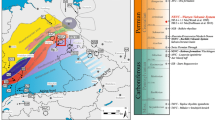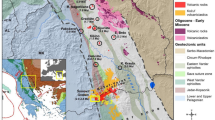Abstract
We describe texture, mineralogy and whole-rock composition of cognate monzonite sub-volcanic clasts within debris flow deposits related to the 5000 years catastrophic phreatomagmatic eruption probably linked to the Sciara del Fuoco sector collapse. The debris flows are at the top of accretionary lapilli-rich ash deposits overlying potassic (KS, shoshonites) lavas of the Neostromboli period. The monzonites are inferred to be crystallized in situ, at low P, at the side walls and/or roof margins of a shallow magma chamber and to be cogenetic with the KS Neostromboli extrusives. They can be considered "ideal orthocumulates" since they approximately retain a bulk liquid composition and possibly represent "slowly cooled equivalents" of their KS shoshonite host rock. The "closure temperature" of final solidification of the monzonite lithic suite was estimated through ternary-feldspar geothermobarometry, plagioclase–K-feldspar and K-feldspar–biotite equilibria and is in the range of 750–790 °C with a maximum –logfO2 around 15.1–15.3. The estimated pressure of crystallization is <0.5 kbar. Potassic lavas and dikes, previously emplaced during the Neostromboli period, also resemble the monzonites in both major trace elements and mineral chemistry. The cogenetic relationship between KS Neostromboli extrusives and the monzonite host-rock magma from which the sub-volcanic clasts were derived is clear evidence that a shallow magma chamber existed between the caldera collapse of the Vancori period and the Sciara del Fuoco sector collapse (i.e. between 13 000 and 5000 years). The monzonite clasts were derived from crystallization at very shallow depth (ca. 1 km) and strongly support the hypothesis of violent decompression of the shallow magmatic plumbing system during the Sciara del Fuoco sector collapse. Climax of the regressive landslide event, with maximum disruption of the chamber walls, took place during emplacement of the debris flows, i.e. during the late stage of the Neostromboli phreatomagmatic eruption.
Similar content being viewed by others
Author information
Authors and Affiliations
Additional information
Received: 15 September 1996 / Accepted: 5 May 1997
Rights and permissions
About this article
Cite this article
Renzulli, A., Santi, P. Sub-volcanic crystallization at Stromboli (Aeolian Islands, southern Italy) preceding the Sciara del Fuoco sector collapse: evidence from monzonite lithic suite. Bull Volcanol 59, 10–20 (1997). https://doi.org/10.1007/s004450050171
Issue Date:
DOI: https://doi.org/10.1007/s004450050171




